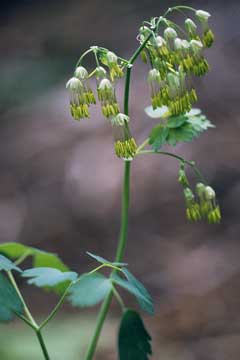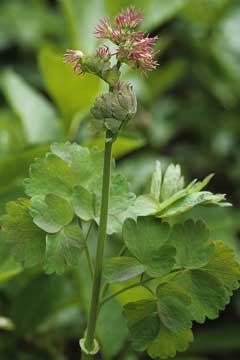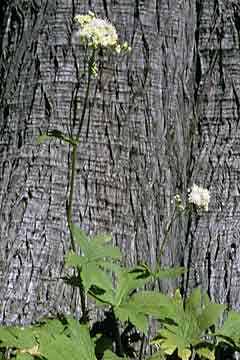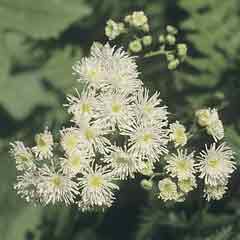 |
Clematis, Clematis spp.
The Greek word klematis referred in the distant past to
a periwinkle (Vinca sp.) and later was applied to this genus. Do
you say "clematis" as "KLEM-atiss" or "klem-AH-tiss"? Take your choice: either
pronounciation is acceptable.
Western virgin’s bower, Clematis
occidentalis
(Hornem.) DC. (left). The western virgin’s bower
is a late spring-blooming, woody, climbing vine that grows in the moist open
shade of montane forests. The flowers are apetalous and the plants'
purple sepals stand out in the subdued light of their surroundings. Three-parted
leaves with toothed, heart-shaped leaflets are a clue that it is in the buttercup
family. A similar species that differs only in the shape of its leaves,
Clematis columbiana (Nutt.) Torr. & Gray, grows in the south-eastern
part of Idaho.
|
 |
Vase-flower, Clematis
hirsutissima Pursh (lef,
tright) known also as the "vase-flower," “sugar-bowl,”
“leather-flower” and “hairy (hirsutissimma)
clematis,” could not be mistaken for any other. Four purple sepals are
joined for much of their length to form a furry “vase” that gives
the flower one of its common names. It is a herbaceous (non-woody) soft-stemmed,
perennial plant, whose flowers are borne on a single stem that arises from
a profusion of frizzy leaves divided into narrow leaflets. The fruit (right)
is "plumose" ; the plume made up of long styles. Vase-flowers prefer moist
ground where they bloom from mid spring to early summer. The plant was unknown
to science until Lewis and Clark collected it in on May 27, 1806, near their
encampment on the Clearwater River near today’s Kamiah, Idaho. |
 |
 |
Western clematis, Clematis
ligusticifolia Nutt.
(left, right). The western clematis prefers dry, open
ground where it forms aggressive, rapidly spreading vines that cover neighboring
trees, shrubs and fences. The plants form masses of white blossoms, followed
by densely hairy fruiting bodies (seen to a lesser extent in other members
of the genus). In this plant the fruiting bodies often coalesce to cover
the plant. The western clematis is sometimes used as an ornamental, but it
tends to spread further and faster than one might wish. The species name
ligusticifolia apparently refers to a perceived similarity between
this plant’s leaves and those of a species of Ligusticum in the
parsley family (Apiaceae). |
 |
 |
Western meadowrue, Thalictrum
occidentale A. Gray. Thalictrums
are found throughout the United States and Canada, but this species occurs
only in the West. Its leaves are three-lobed and their are separate male
and female plants. Male plants (left) are distinguished by fringe-like dependent
anthers. Female plants (right) have wispy pinkish petals. Meadowrues provide
ground-cover in shady woods, and are sometimes grown for that purpose in
shaded gardens. Thaliktron was used by Dioscorides for a Greek plant,
and later became attached to this genus. True rue is an unrelated evergreen
shrub, Ruta graveolens, with an unpleasant aromatic odor. Our plants
have a similar odor, so they became “meadowrues.” Western meadow-rue
was first collected by the explorer Captain John Charles Frémont
(1830-1890) in Wyoming in 1843. |
 |
 |
False bugbane, Trautvetteria
carolinensis (Walter) Vail
(left, right) The false bugbane, as its
scientific name suggests, also grows in the southeastern United States. It
prefers shaded streambanks and moist forests where the ground is often covered
with their large maple-leaf shaped leaves. The flowers are small and gathered
into clusters. The generic name, Trautvettaria, honors Russian botanist
Ernest Rudolf van Trautvetter (1809-1889). Our plant resembles the true bugbane,
a related European ornamental, Cimicifuga foetida L. used in the past
as an insect repellant. The trautvettaria shown here was photographed in
the DeVoto Grove, a few miles west of the Lolo Pass summit. The tree is one
of the grove’s magnificent western red cedars, Thuja
plicata. |
 |
 |
Globeflower, Trollius
albiflorus (A. Gray) Rydb. (left). The name
Trollius was derived from the Swiss-German name trollblume
for a closely related globeflower Trollius
laxus. The latter is a circumboreal Eurasian plant:
our species is possibly a variant of that plant. Globeflowers bloom
very early on south facing slopes as winter turns into spring, often while
the ground is still mostly snow-covered. Its basal leaves are palmately lobed
and toothed, although they are usually not out when the flowers open.
|









